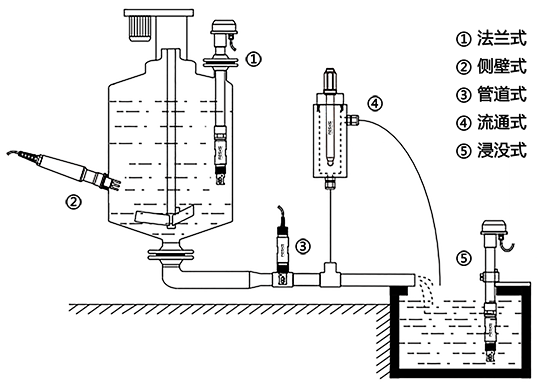The United KingdomFESKS FiskeOfhigh temperaturePH electrode KSPH 170G is a composite electrode (measurement+ Reference), has good high temperature resistance and can withstand it for a long timeMaximum130 ℃High temperatures around the world have a long service life in the fermentation industry,Suitable for high-temperature fermentation, bacterial culture and other high-temperature solutionsContinuous monitoring of pH value.
☞ Supporting controller:
FSPH 3700 Basic Controller
FSPH5280 Intelligent Controller
Technical parameters
Measuring range: | 0~14pH |
Temperature range: | 0~130℃ |
Points distinguish Rate: | 0.01pH |
Essence True Degree: | ±0.01pH |
Pressure range: | 0~6Bar |
Type of warm tonic: | Pt1000 |
film Electricity Resistance: | < 250MΩ |
zero Electricity Bit: | 7±0.25pH |
Response time: | < 30S |
Salt bridge type: | porous ceramic wick |
Reference type: | Ag/AgCl |
Electrode material: | Glass |
Electricity Solution Liquid: | Gel |
Mounting threads: | PG13.5 |
Electrode size: | ∅12*120mm |
Cable length: | standard5m |
KSPH Series PH/ORP Electrodes selection KSPH 130A electrode suitable for generalSewage, tap waterOfpH measurement KSPH 130B electrode Applicable toheavy metal, organic, high chlorine, ammonia water, chemicalsewagepH measurement KSPH 155T electrode Applicable todesulfurizationOfpH measurement KSPH 160HF electrode Applicable tocontaining hydrofluoric acidwater bodypH measurement KSPH 170G electrode suitable for generalhigh temperature mediumOfpH measurement KSPH 170GF electrode Applicable tohigh-temperature fermentationOfpH measurement KSPH 170GH electrode Applicable tohigh temperature heavy metals, organic, high chlorine, ammonia water, chemicalOfpH measurement KSPH 180D electrode Applicable tolow temperature mediumOfpH measurement KSPH 185C electrode Applicable toPure water,RO waterwater body with low conductivitypH measurement KSOP 190 electrode suitable for generalWater treatment, highly polluting wastewaterOfORP value measurement Daily repair and maintenance of electrodes: 1. General contamination: Wash the electrode with water, 0.1 moL/INaOH or 0.1 moL/L HCI for several minutes. 2. Oil or organic contamination: Wash the electrodes with acetone or ethanol for a few seconds. 3. Sulfide contamination (black membrane): Wash with a mixture of 10% HCL and saturated thiourea. 4. Protein contamination (yellowing of diaphragm): Use 10% HCL and saturated gastric protein. Wash the enzyme mixture. Note: When the tested medium has sulfide pollution or protein pollution on the electrode, it should be dealt with promptly. Storage of electrodes: 1. When the electrode is not used for a long time, it should be stored in saturated KCL solution or buffer solution. 2. The electrode cannot be dried for a long time, and the electrode cannot be stored when a dry medium is attached to the surface. Dry electrodes should be placed in a suitable preservation solution for activation before being used. 3. The electrode can be activated in buffer at pH4 or in 3M HCl (or saturated KCL). 4. Electrodes cannot be stored in distilled water.
electrode mounting

The United KingdomFESKS FiskeOfhigh temperaturePH electrode KSPH 170G is a composite electrode (measurement+ Reference), has good high temperature resistance and can withstand it for a long timeMaximum130 ℃High temperatures around the world have a long service life in the fermentation industry,Suitable for high-temperature fermentation, bacterial culture and other high-temperature solutionsContinuous monitoring of pH value.
☞ Supporting controller:
FSPH 3700 Basic Controller
FSPH5280 Intelligent Controller
Technical parameters
Measuring range: | 0~14pH |
Temperature range: | 0~130℃ |
Points distinguish Rate: | 0.01pH |
Essence True Degree: | ±0.01pH |
Pressure range: | 0~6Bar |
Type of warm tonic: | Pt1000 |
film Electricity Resistance: | < 250MΩ |
zero Electricity Bit: | 7±0.25pH |
Response time: | < 30S |
Salt bridge type: | porous ceramic wick |
Reference type: | Ag/AgCl |
Electrode material: | Glass |
Electricity Solution Liquid: | Gel |
Mounting threads: | PG13.5 |
Electrode size: | ∅12*120mm |
Cable length: | standard5m |
KSPH Series PH/ORP Electrodes selection KSPH 130A electrode suitable for generalSewage, tap waterOfpH measurement KSPH 130B electrode Applicable toheavy metal, organic, high chlorine, ammonia water, chemicalsewagepH measurement KSPH 155T electrode Applicable todesulfurizationOfpH measurement KSPH 160HF electrode Applicable tocontaining hydrofluoric acidwater bodypH measurement KSPH 170G electrode suitable for generalhigh temperature mediumOfpH measurement KSPH 170GF electrode Applicable tohigh-temperature fermentationOfpH measurement KSPH 170GH electrode Applicable tohigh temperature heavy metals, organic, high chlorine, ammonia water, chemicalOfpH measurement KSPH 180D electrode Applicable tolow temperature mediumOfpH measurement KSPH 185C electrode Applicable toPure water,RO waterwater body with low conductivitypH measurement KSOP 190 electrode suitable for generalWater treatment, highly polluting wastewaterOfORP value measurement Daily repair and maintenance of electrodes: 1. General contamination: Wash the electrode with water, 0.1 moL/INaOH or 0.1 moL/L HCI for several minutes. 2. Oil or organic contamination: Wash the electrodes with acetone or ethanol for a few seconds. 3. Sulfide contamination (black membrane): Wash with a mixture of 10% HCL and saturated thiourea. 4. Protein contamination (yellowing of diaphragm): Use 10% HCL and saturated gastric protein. Wash the enzyme mixture. Note: When the tested medium has sulfide pollution or protein pollution on the electrode, it should be dealt with promptly. Storage of electrodes: 1. When the electrode is not used for a long time, it should be stored in saturated KCL solution or buffer solution. 2. The electrode cannot be dried for a long time, and the electrode cannot be stored when a dry medium is attached to the surface. Dry electrodes should be placed in a suitable preservation solution for activation before being used. 3. The electrode can be activated in buffer at pH4 or in 3M HCl (or saturated KCL). 4. Electrodes cannot be stored in distilled water.
electrode mounting

